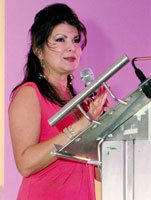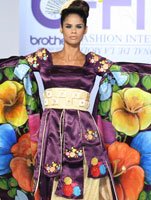Fashioning School Spirit
Jannette Klein and Brother International put a fashionable focus on student competition and Mexico’s design community.
MEXICO CITY—When the male models hit the runway at the Brother Fashion International View design showcase and student competition, the piercing screams reached decibels usually reserved for boy bands.
When MGP, an actual boy band, took to the stage, the audience—primarily young, female design students—went wild.
The scene was part of a three-day fashion extravaganza organized by Jannette Klein, founder of the Jannette Klein Campus de la Moda, a 23-year-old design school based in Mexico City. Now in its 12th year, Brother Fashion International View is part student design competition and part indoctrination into Mexico’s fashion industry. This year’s event, held May 26–28 at restaurant and convention center Ambrosia, drew about 1,300 students from more than 70 design schools across Mexico. Every day, from 9 a.m. to 9 p.m., the students watched fashion shows from a veritable who’s who of established and up-and-coming designers and retailers, attended industry-focused seminars, and browsed among the displays by some of the event’s sponsors. Title sponsor Brother International had the largest display, where attendees could check out the company’s home-sewing and professional-grade models.
Los Angeles–based designer Louis Verdad, who grew up in Leon, Mexico, was this year’s featured designer, an honor that included a finale runway-show retrospective of his work.
Verdad was one of more than 35 designers featured at the event, which also included runway shows hosted by local retail chains and several student design competitions.
The two main competitions were for Valentino-inspired bridal gowns and eveningwear that blended Parisian couture with traditional Japanese motifs. More than 70 student designers from 27 schools participated in each competition.
Other competitions, sponsored by Swarovski and Converse, highlighted crystal embellishment and sneaker style, respectively.
Brother sponsored the “Harajuku Girls” runway show, in which students were instructed to use as much embellishment as possible—using Brother embroidery machines, of course—to create designs inspired by Tokyo street style.
Several of the competition winners took home Brother sewing machines. And throughout the show, the sewing-machine maker ran demonstrations of its products, including a top-of-the-line embroidery machine that comes preprogrammed with 100 embroidery designs and has a USB port for uploading custom designs. At 8,000 pesos, the semi-industrial machine is “a big investment,” said Brother Product Manager Sonia Magana Ramos. The machine, which has attachment kits for embroidering caps and jeans, was a hit at the show, where demonstrations quickly drew a crowd of students and design-school instructors.
The bulk of Brother’s business—70 percent—is within the home-sewing market, said Magana Ramos, who said the company’s industrial division is looking for special promotions to target fashion entrepreneurs. “It’s very focused for business,” she said.
Other exhibitors included Ozynx, a Leon-based footwear collection produced by a longtime maker of private-label footwear. Ozynx is the footwear maker’s first branded collection, and the fanciful shoes feature laser-etched designs—this year inspired by dragons and next year inspired by the sea and sirens—rendered in man-made materials.
At the center of it all is Klein, who serves as host for the three-day event. The ebullient design instructor also maintains a small booth at the show for her school, although she said she prefers the school keep a low profile at the event to keep the focus on the students and the designers on the runway.
A Fashion Institute of Design & Merchandising graduate, Klein opened her school in 1985, and today she runs the program with her husband, Xavier Reyes. The school maintains an exchange program with FIDM, and each year two students from Mexico spend a quarter taking classes at FIDM’s Los Angeles campus.
Since launching Brother Fashion International View in 1996, Klein runs the event with the help of about 100 staffers and 70 student volunteers.
For about $60, attendees take in the nonstop round of fashion shows and conferences. Students are bused in from all over the country, taking over hotels surrounding the event venue in the south side of Mexico City.
Focus on local talent
Brother Fashion International View gives students an opportunity to compete against other design schools, and the seminar program gives them a crash course in industry issues. But perhaps most important, the three-day event gives them an introduction to the breadth of design talent coming out of Mexico.
The education began at the opening ceremony, where famed Mexico City designer Pedro Loredo cut the ribbon to signal the start of the event. Throughout the three days, attendees got an overview of Mexico design that ranged from glamorous evening gowns and theatrical ensembles to day dresses and contemporary streetwear.
The runway lineup is handpicked by Klein, who chose a mix of established and up-and-coming designers, many of whom are former students.
“This time there are so many new designers,” she said, noting that the designers came from across the country, from Mexico City, Guadalajara, Monterrey, Cuernavaca and Veracruz.
“A lot of people never have this opportunity,” said Guillermo Leoacute;n, a former student of Klein’s and one of the designers featured on the runway this year. “All the industry together helps students know about runway and design and the industry.”
Runway highlights included Cubo’s contemporary women’s and men’s apparel in slim silhouettes and Sergio Alcalaacute;’s ’80s-inspired streetwear and swimwear in Day-Glo colors with indigenous Mexican design motifs.
Jewelry designer Gustavo Helguera showed dramatic pieces, including waterfall necklaces, bracelets that snaked around an arm and headpieces that followed the curve of the cheekbone.
Santo’s menswear borrowed elements from motorcycle culture and punk rock, and Carlo Demichelis’ knitwear was sophisticated and subtle.
Several designers showed red carpet–ready gowns, including Alvaro Intilde;iguez, Aracely Garcia, Arturo Jimeacute;nez and Jorge Castellanos.
Malafacha and Ivaacute;n San Juan both channeled Goth looks for chic collections in somber shades of black and charcoal.
For more information about Brother Fashion International View, visit www.bfiv.com.mx. For more information about the Janette Klein Campus de la Moda, visit www.jk.edu.mx or jannetteklein.edu.mx.

























